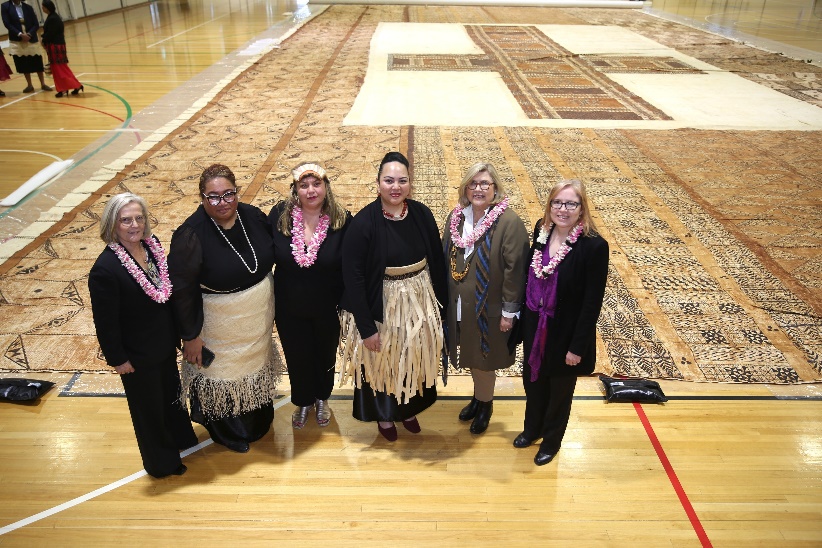One of the world’s largest Tapa bark cloths, Ngatu Me’a’ofa (Gifted Tapa / Bark Cloth), was unveiled in full for the first time in almost 50 years this morning in a special ceremony attended by HRH Princess Angelika Halaevalu Mata’aho Napua ‘Okalani Tuku’aho, Princess of Tonga, as part of a unique cultural collaboration between the Australian Museum and the Sydney Opera House.
The Ngatu Me’a’ofa was a gift from the people of Tonga to the Sydney Opera House Trust for its opening by Queen Elizabeth 11 in 1973 and used during the opening ceremonies. Due to its fragility and size – 29m x 15m – it was gifted to the Australian Museum where it has remained in climate-controlled storage and has not been seen in its entirety in five decades. It is one of the largest objects in the AM’s collection and one of the largest Tapa bark cloths in the world.
Today the Ngatu Me’a’ofa, which is made from the inner bark of paper mulberry trees, was lifted by two cranes out of the Museums Discovery Centre, a purpose-built storage facility in Castle Hill, and transported by a semi-trailer to a large space at the Blacktown Leisure Centre – a region of Western Sydney that is home to many Pacific Island communities. The cloth was unrolled, digitised and checked by the AM’s Conservation team as part of the Ngatu Me’a’ofa Digitisation Project, ahead of its planned digital display in the AM’s new Pasifika Gallery, which opens in October.
It was the first time since 1973 the Ngatu Me’a’ofa was unrolled in full. It was last partially unrolled in 1996 for cleaning and conservation checks.
The Tapa cloth holds special cultural significance to the people of Tonga. Considered a ‘fabric of life’ it is made from the paper mulberry tree, (Broussonetia papyrifera), and is central to their society, culture and spirituality. Used for thousands of years in weddings, ceremonies and celebrations, the Tapa cloth is a sacred gift from one family to another.
From L to R: Sydney Opera House Trust Chair Lucy Turnbull AO, AM Manager, Pacific Collections, Melissa Malu, AM director of First Nations, Laura McBride, HRH Princess Angelika Halaevalu Mata’aho Napua ‘Okalani Tuku’aho, Princess of Tonga, AM Director and CEO Kim McKay AO, Parliamentary Secretary to the Premier and Parliamentary Secretary for the Arts, Julia Finn MP. Photo by James Alcock.
Today’s special ceremony was attended by HRH Princess Angelika Halaevalu Mata’aho Napua ‘Okalani Tuku’aho, Princess of Tonga, Parliamentary Secretary to the Premier and Parliamentary Secretary for the Arts, Julia Finn MP, the AM’s Director and CEO Kim McKay AO, Sydney Opera House Trust Chair Lucy Turnbull AO, Blacktown City Council’s Councillor Dr Moninder Singh, and members of Australia’s Tongan and Pacific communities.
The AM’s Director of First Nations, Laura McBride, said the digitisation of the Ngatu Me’a’ofa is critical to the AM’s relationship with its Pacific neighbours.
“Bark cloths are made by women from trees planted by the men and the Ngatu Me’a’ofa / Tapa Cloth can be seen as a metaphor for Tongan society. It serves as a tangible vehicle for cultural identity and meaningful social connections between the Tongan diaspora and the people of the Kingdom of Tonga. Therefore it is fitting that the Ngatu Me’a’ofa be recognised as a cultural treasure,” McBride said.
“For the past eight months, our team has been working with communities to prioritise what items in our collection are digitised for accessibility purposes so community members can see important cultural items whenever they visit the Museum. This project was led by the AM’s Melissa Malu, a Tongan and Fijian woman and the AM’s Manager of Pasifika Collections and Engagement, who has worked very closely with Her Royal Highness and the Pacific Island diaspora, to uphold the cultural ways of the Pasifika people,” McBride said.
Australian Museum Director and CEO, Kim McKay, AO, said today’s unveiling of the Ngatu Me’a’ofa is an example of the Museum’s priority to be a strong advocate for First Nations culture.
“Museum collections advance our understanding of science, culture and our environment by forming and broadening our vision. The digitisation of our cultural collections provides the AM with a range of possibilities for sharing curatorial and cultural information with the communities of origin,” McKay explained.
“The AM’s Pacific collection is one of the most significant in the world with over 60,000 objects from across the entire Pacific region. Exhibitions like the newly opened Bilas: Body Adornment of Papua New Guinea and the new Pasifika Gallery showcase both the Museum’s historical and contemporary Pacific collections and through the digitisation project ensure the preservation of the AM’s cultural collections for generations to come,” McKay added.
Sydney Opera House Trust Chair Lucy Turnbull AO said: “I was delighted to participate in today’s event celebrating the 1973 gift of the Ngatu Me’a’ofa for the Opera House’s opening and to be reminded of the huge act of generosity of the Tongan people. It is wonderful that the Tapa bark cloth will be digitised and displayed in the Museum’s new Pasifika Gallery so that it can be seen, enjoyed, and appreciated by the whole community. It’s especially significant that the opening of the new gallery coincides with our 50th birthday celebrations in October, as we work to achieve our ambition for the Opera House to be Everyone’s House.”
#









